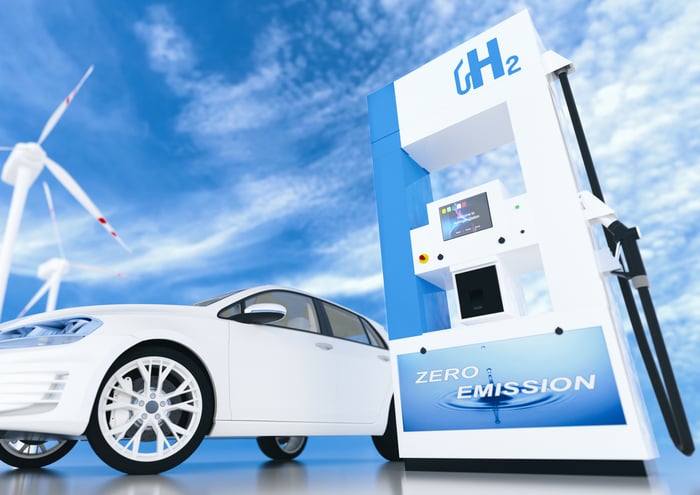Plug Power (PLUG -9.49%) has become the poster child for the hydrogen economy. The stock is up 1,170% in two years. That means, if you had invested just $86,000 in Plug Power in July 2019, your investment would have risen to more than $1 million right now. What's more, you could have made a cool $2.7 million had you sold it in January when it was trading above $73.
Obviously, it is easy to find multibagger stocks and their best entry and exit points in the hindsight. The key question today is -- can the stock generate similar returns in the future?
What does Plug Power do?
The company makes hydrogen fuel cells, which can produce electricity using hydrogen as an input fuel. The best part of producing electricity using hydrogen fuel cells is that they produce only water vapor as a by-product. There are no other emissions, so it is a completely clean way of producing electricity.

Image source: Getty Images.
Plug Power's fuel cells are used in forklifts and in stationary backup power systems. The company is now targeting the fuel cell electric vehicles (FCEVs) market and has entered some key partnerships, including with Renault and Korea's SK Group, to supply its fuel cells to FCEV makers.
While producing electricity using hydrogen sounds great, the process faces some key challenges. First, around 95% of all hydrogen in the U.S. is currently produced using natural gas. So, it isn't really as clean an energy source as is pitched. Fuel cell companies aim to use green hydrogen, produced from water through a process called electrolysis, as an input fuel. Though it would be environmentally friendly, it is a far more costly process.
Moreover, for FCEVs to gain traction, there needs to be refueling infrastructure in place, which isn't the case at the moment. That will require lots of investment and policy support from the government to develop the needed infrastructure. Hydrogen fuel is highly combustible, which adds to its storage and transport costs. With the falling costs of lithium-ion batteries, the incentive to develop hydrogen infrastructure may not be huge. Overall, it isn't a smooth road ahead for hydrogen fuel cell makers.

Image source: Getty Images.
Can Plug Power deliver on its plans?
Plug Power has been facing the above challenges over the years. Though the company's revenue has grown significantly, it is still making losses after more than two decades of operations. Plug Power aims to generate gross margin of more than 30% by 2024. That looks like an ambitious target. The management hasn't been able to meet its guidance numbers several times in the past. For example, Plug Power hoped to achieve EBITDAS (earnings before interest, taxes, depreciation, amortization, and stock-based compensation)-breakeven in 2014, but hasn't achieved that even today. Again, the company expected to be cash flow positive in 2017 and beyond. It isn't so, even today.
PLUG Cash from Operations (Quarterly) data by YCharts
While Plug Power's revenue growth is commendable, it will need to generate profits to survive in the long run. It cannot endlessly continue to dilute existing shareholders to fund its operations as it has been doing in the past.
Is Plug Power a millionaire-maker?
Considering the challenges discussed above, as well as Plug Power's performance so far, it would be difficult for the stock to rise back even to its recent highs of $73. Even if it does, you'd need to invest around $660,000 today for your investment to reach a million. That's a substantial amount to invest in a risky stock like Plug Power. Plug Power's chances of becoming a millionaire-maker stock are very slim.






